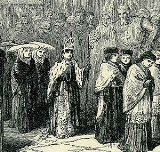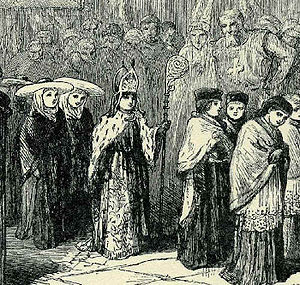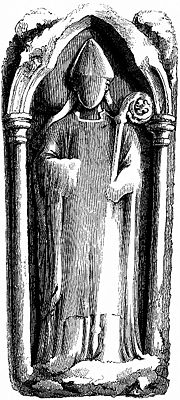
Boy bishop
Encyclopedia
Boy bishop was a name given to a custom very widespread in the Middle Ages
, whereby a boy was chosen, for example among cathedral choristers, to parody the real Bishop, commonly on the feast of Holy Innocents. This custom was linked with others, such as that of the Feast of Fools
and the Feast of Asses.
, the patron of children, and his authority lasted till Holy Innocents' day (28 December). The real Bishop would, symbolically, step down at the deposuit potentes de sede of the Magnificat
("he hath put down the mighty from their seat"), and the boy would take his seat at et exaltavit humiles ("and hath exalted the humble and meek").
After the election, the boy was dressed in full bishop's robes with mitre
and crozier and, attended by comrades dressed as priests, made a circuit of the town blessing the people.
Typically the chosen boy and his colleagues took possession of the cathedral
and performed all the ceremonies and offices, except Mass
. Originally, it seems, confined to the cathedrals, the custom spread to many parishes.
Notwithstanding the intervention of various Church authorities (see Feast of Fools
), the popularity of the custom made it resistant. In England it was abolished by Henry VIII
in 1542, revived by Mary I
in 1552 and finally abolished by Elizabeth I
. On the continent it survived longest in Germany
, in the so-called Gregoriusfest, said to have been founded by Gregory IV.
 There have been some recent revivals both in the English-speaking world and on the continent. Most famous perhaps is that of Hereford
There have been some recent revivals both in the English-speaking world and on the continent. Most famous perhaps is that of Hereford
, revived in 1973 for a special children's service, with full and traditional ceremonies following annually since 1982. The Boy Bishop preaches a sermon and leads prayers at various Diocesan Advent services. A single revival took place in 1959 at St. George's Parish Church http://www.stgeorgestockport.org.uk/stgeorgesheaviley.htm, Stockport
. Such ceremonies are now also found at Westminster Cathedral
, Salisbury Cathedral
, and a number of parish churches throughout England, including Claines
, Worcestershire, and also St Christopher's Parish Church, Bournemouth, (early 1950s), where the Boy Bishop was installed on St Christopher's Day, (July 25), and 'reigned' for one year, preaching and 'presiding' at youth events.
The custom was likewise revived in Burgos
, Spain
, where the boy-bishop feast had been extremely popular before the cathedral choir
was closed in the 1930s. After its re-establishment, the boy bishop was revived in 1987, and has since been celebrated every year. Other Spanish cities such as Palencia
also hold the ceremony, and that carried on in the Monastery of Montserrat by L'Escolania
is especially renowned. The festival was also revived in Chavagnes International College
, a Catholic
boarding school in France
.
In the United States
, one of the first adoptions of the custom took place in 1979 at the Cathedral of All Saints (Episcopal) in Albany
, New York
, as part of an annual medieval fair held in the great Gothic-revival style church.
Middle Ages
The Middle Ages is a periodization of European history from the 5th century to the 15th century. The Middle Ages follows the fall of the Western Roman Empire in 476 and precedes the Early Modern Era. It is the middle period of a three-period division of Western history: Classic, Medieval and Modern...
, whereby a boy was chosen, for example among cathedral choristers, to parody the real Bishop, commonly on the feast of Holy Innocents. This custom was linked with others, such as that of the Feast of Fools
Feast of Fools
The Feast of Fools, known also as the festum fatuorum, festum stultorum, festum hypodiaconorum, or fête des fous, are the varying names given to popular medieval festivals regularly celebrated by the clergy and laity from the fifth century until the sixteenth century in several countries of Europe,...
and the Feast of Asses.

History
In England the boy bishop was elected on 6 December, the feast of Saint NicholasSaint Nicholas
Saint Nicholas , also called Nikolaos of Myra, was a historic 4th-century saint and Greek Bishop of Myra . Because of the many miracles attributed to his intercession, he is also known as Nikolaos the Wonderworker...
, the patron of children, and his authority lasted till Holy Innocents' day (28 December). The real Bishop would, symbolically, step down at the deposuit potentes de sede of the Magnificat
Magnificat
The Magnificat — also known as the Song of Mary or the Canticle of Mary — is a canticle frequently sung liturgically in Christian church services. It is one of the eight most ancient Christian hymns and perhaps the earliest Marian hymn...
("he hath put down the mighty from their seat"), and the boy would take his seat at et exaltavit humiles ("and hath exalted the humble and meek").
After the election, the boy was dressed in full bishop's robes with mitre
Mitre
The mitre , also spelled miter, is a type of headwear now known as the traditional, ceremonial head-dress of bishops and certain abbots in the Roman Catholic Church, as well as in the Anglican Communion, some Lutheran churches, and also bishops and certain other clergy in the Eastern Orthodox...
and crozier and, attended by comrades dressed as priests, made a circuit of the town blessing the people.
Typically the chosen boy and his colleagues took possession of the cathedral
Cathedral
A cathedral is a Christian church that contains the seat of a bishop...
and performed all the ceremonies and offices, except Mass
Mass (liturgy)
"Mass" is one of the names by which the sacrament of the Eucharist is called in the Roman Catholic Church: others are "Eucharist", the "Lord's Supper", the "Breaking of Bread", the "Eucharistic assembly ", the "memorial of the Lord's Passion and Resurrection", the "Holy Sacrifice", the "Holy and...
. Originally, it seems, confined to the cathedrals, the custom spread to many parishes.
Notwithstanding the intervention of various Church authorities (see Feast of Fools
Feast of Fools
The Feast of Fools, known also as the festum fatuorum, festum stultorum, festum hypodiaconorum, or fête des fous, are the varying names given to popular medieval festivals regularly celebrated by the clergy and laity from the fifth century until the sixteenth century in several countries of Europe,...
), the popularity of the custom made it resistant. In England it was abolished by Henry VIII
Henry VIII of England
Henry VIII was King of England from 21 April 1509 until his death. He was Lord, and later King, of Ireland, as well as continuing the nominal claim by the English monarchs to the Kingdom of France...
in 1542, revived by Mary I
Mary I of England
Mary I was queen regnant of England and Ireland from July 1553 until her death.She was the only surviving child born of the ill-fated marriage of Henry VIII and his first wife Catherine of Aragon. Her younger half-brother, Edward VI, succeeded Henry in 1547...
in 1552 and finally abolished by Elizabeth I
Elizabeth I of England
Elizabeth I was queen regnant of England and Ireland from 17 November 1558 until her death. Sometimes called The Virgin Queen, Gloriana, or Good Queen Bess, Elizabeth was the fifth and last monarch of the Tudor dynasty...
. On the continent it survived longest in Germany
Germany
Germany , officially the Federal Republic of Germany , is a federal parliamentary republic in Europe. The country consists of 16 states while the capital and largest city is Berlin. Germany covers an area of 357,021 km2 and has a largely temperate seasonal climate...
, in the so-called Gregoriusfest, said to have been founded by Gregory IV.
Revivals

Hereford Cathedral
The current Hereford Cathedral, located at Hereford in England, dates from 1079. Its most famous treasure is Mappa Mundi, a mediæval map of the world dating from the 13th century. The cathedral is a Grade I listed building.-Origins:...
, revived in 1973 for a special children's service, with full and traditional ceremonies following annually since 1982. The Boy Bishop preaches a sermon and leads prayers at various Diocesan Advent services. A single revival took place in 1959 at St. George's Parish Church http://www.stgeorgestockport.org.uk/stgeorgesheaviley.htm, Stockport
Stockport
Stockport is a town in Greater Manchester, England. It lies on elevated ground southeast of Manchester city centre, at the point where the rivers Goyt and Tame join and create the River Mersey. Stockport is the largest settlement in the metropolitan borough of the same name...
. Such ceremonies are now also found at Westminster Cathedral
Westminster Cathedral
Westminster Cathedral in London is the mother church of the Catholic community in England and Wales and the Metropolitan Church and Cathedral of the Archbishop of Westminster...
, Salisbury Cathedral
Salisbury Cathedral
Salisbury Cathedral, formally known as the Cathedral Church of the Blessed Virgin Mary, is an Anglican cathedral in Salisbury, England, considered one of the leading examples of Early English architecture....
, and a number of parish churches throughout England, including Claines
Claines
Claines is a small village just to the north of Worcester, England, on the left bank of the River Severn. Claines is situated in the heart of Worcestershire on the A449 between Worcester and Kidderminster. It has a church which dates from the 10th Century....
, Worcestershire, and also St Christopher's Parish Church, Bournemouth, (early 1950s), where the Boy Bishop was installed on St Christopher's Day, (July 25), and 'reigned' for one year, preaching and 'presiding' at youth events.
The custom was likewise revived in Burgos
Burgos
Burgos is a city of northern Spain, historic capital of Castile. It is situated at the edge of the central plateau, with about 178,966 inhabitants in the city proper and another 20,000 in its suburbs. It is the capital of the province of Burgos, in the autonomous community of Castile and León...
, Spain
Spain
Spain , officially the Kingdom of Spain languages]] under the European Charter for Regional or Minority Languages. In each of these, Spain's official name is as follows:;;;;;;), is a country and member state of the European Union located in southwestern Europe on the Iberian Peninsula...
, where the boy-bishop feast had been extremely popular before the cathedral choir
Choir
A choir, chorale or chorus is a musical ensemble of singers. Choral music, in turn, is the music written specifically for such an ensemble to perform.A body of singers who perform together as a group is called a choir or chorus...
was closed in the 1930s. After its re-establishment, the boy bishop was revived in 1987, and has since been celebrated every year. Other Spanish cities such as Palencia
Palencia
Palencia is a city south of Tierra de Campos, in north-northwest Spain, the capital of the province of Palencia in the autonomous community of Castile-Leon...
also hold the ceremony, and that carried on in the Monastery of Montserrat by L'Escolania
L'Escolania
L'Escolania choir school is a boys' choir of sopranos and altos based at the Benedictine abbey Santa Maria de Montserrat near Barcelona, Catalonia, Spain...
is especially renowned. The festival was also revived in Chavagnes International College
Chavagnes International College
Chavagnes International College is a Catholic school for boys in Chavagnes-en-Paillers, France. Founded in 1802 by Louis-Marie Baudouin the school was re-fashioned an "international college" by Ferdi McDermott in 2002...
, a Catholic
Roman Catholic Church
The Catholic Church, also known as the Roman Catholic Church, is the world's largest Christian church, with over a billion members. Led by the Pope, it defines its mission as spreading the gospel of Jesus Christ, administering the sacraments and exercising charity...
boarding school in France
France
The French Republic , The French Republic , The French Republic , (commonly known as France , is a unitary semi-presidential republic in Western Europe with several overseas territories and islands located on other continents and in the Indian, Pacific, and Atlantic oceans. Metropolitan France...
.
In the United States
United States
The United States of America is a federal constitutional republic comprising fifty states and a federal district...
, one of the first adoptions of the custom took place in 1979 at the Cathedral of All Saints (Episcopal) in Albany
Albany, New York
Albany is the capital city of the U.S. state of New York, the seat of Albany County, and the central city of New York's Capital District. Roughly north of New York City, Albany sits on the west bank of the Hudson River, about south of its confluence with the Mohawk River...
, New York
New York
New York is a state in the Northeastern region of the United States. It is the nation's third most populous state. New York is bordered by New Jersey and Pennsylvania to the south, and by Connecticut, Massachusetts and Vermont to the east...
, as part of an annual medieval fair held in the great Gothic-revival style church.
Recent works
- A. Ward, "Richard Ramsey's Sermon for a Boy Bishop (Tudor Catholic Sermons 2)", in Ephemerides Liturgicae 111 (1997) 476-505.
- A. Ward, "A Sermon for A Boy Bishop by John Alcock, Bishop of Ely (1430-1486-1500)", in Ephemerides Liturgicae 112 (1998) 58-81.
- N. Mackenzie, The Medieval Boy Bishops, 2012.
Less recent
- John Gough Nichols (ed.), "Two Sermons pronounced by the Boy Bishop at St. Paul's, Temp. Henry VIII, and at Gloucester, Temp. Mary", in Camden Miscellany, Volume the Seventh, Camden SocietyCamden SocietyThe Camden Society, named after the English antiquary and historian William Camden, was founded in 1838 in London to publish early historical and literary materials, both unpublished manuscripts and new editions of rare printed books....
, 1875. - W.C. Meller, The Boy Bishop and other Essays on Forgotten Customs and Beliefs of the Past, London 1923, pp. 3–18
- A. Gastá‚ "Les Drames liturgiques de la cathédrale de Rouen", in Revue catholique de Normandie 2 (1893) 349-372, 477-500, 573-605.
- T.H.V. Motter, The School Drama in England, London 1929, pp. 6–8, 11-12, 31, 33, 49-50, 229, 252.
- J.P.W. Crawford, "A Note on the Boy Bishop in Spain", in Romanic Review 12 (1921) 146-154.
- Madeleine Charles, "Le drame liturgique", in La Vie et les arts liturgique 3 (1916–1917) 65-70, 121-134, 169-181, 258-266, 297-307, 403-412, esp. 404-406
- J. M. J. FletcherJ. M. J. FletcherThe Reverend James Michael John Fletcher MA , was an English clergyman of the Church of England, author and historian.-Career:*Vicar of Tideswell*Canon of Salisbury*Fellow of the Royal Historical Society-Publications:...
, The Boy Bishop at Salisbury and Elsewhere, Salisbury [1921]
Classic works on religious and liturgical drama
- C.M. Gayley, Plays of our Forefathers, New York, 1907, pp. 54–61.
- E.K. Chambers, The Medieval Stage, 1903, vol. 1, pp. 336–371.
- R.B. Donovan, The Liturgical Drama in Medieval Spain, 1958.
- H. Craig, English Religious Drama of the Middle Ages, 1955.
- F. Arens (ed.) Der Liber Ordinarius der Essener Stiftskirche, Paderborn, 1908, p. 213.
- J.P.W. Crawford, Spanish Drama before Lope de Vega, Philadelphia 1922 (= Publications of the University of Philadelphia, Extra Series in Languages and Literatures 7), pp. 15–16.
- V. De Bartholomaeis, Le Origini della Poesia drammatica italiana, Bologna [1924], pp. 201–211

